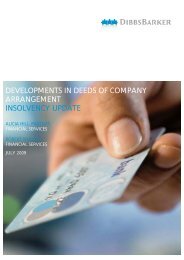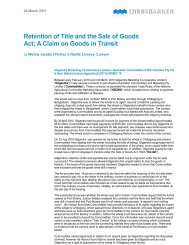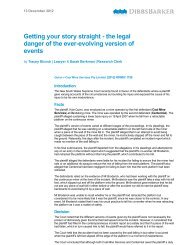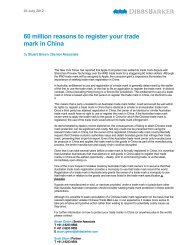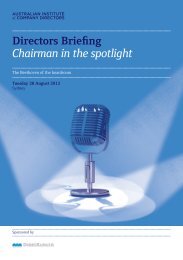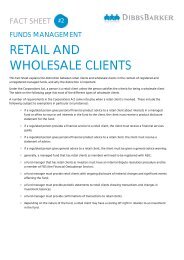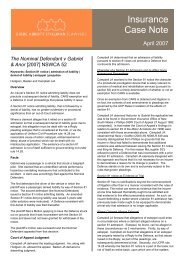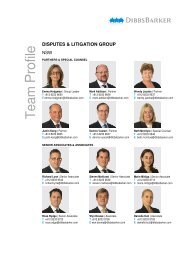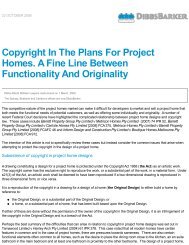What's New in Commonwealth Compensation - DibbsBarker
What's New in Commonwealth Compensation - DibbsBarker
What's New in Commonwealth Compensation - DibbsBarker
Create successful ePaper yourself
Turn your PDF publications into a flip-book with our unique Google optimized e-Paper software.
In terms of the Applicant’s back condition, it was common ground that, pursuant to section 124 of<br />
the Safety, Rehabilitation and <strong>Compensation</strong> Act 1988 (Cth) (“1988 Act”), liability for permanent<br />
impairment of the Applicant’s back would only arise if the impairment became permanent after 1<br />
Liability was accepted under the Safety, Rehabilitation and <strong>Compensation</strong> Act 1988 (Cth) (“1988<br />
Act”) for the Applicant’s “m<strong>in</strong>or annular tear of the L5/S1 disc result<strong>in</strong>g <strong>in</strong> degenerative changes at<br />
the L4/L5 and L5/S1 level” with effect from 10 June 1991. Subsequently, liability was accepted for<br />
conditions of chronic adjustment disorder, pa<strong>in</strong> disorder and major depressive disorder. The<br />
Respondent <strong>in</strong>itially decided <strong>in</strong> April 2009 that the Applicant was assessed as hav<strong>in</strong>g a whole person<br />
impairment of 15 per cent under Table 5.1 of the first edition of the Comcare Guide for his chronic<br />
adjustment disorder only. That decision was affirmed on reconsideration. In June 2009 on further<br />
reconsideration, the delegate varied the decision to assess whole person impairment of 15 per cent<br />
for major depressive disorder and pa<strong>in</strong> disorder <strong>in</strong>stead of chronic adjustment disorder.<br />
The follow<strong>in</strong>g issues were relevant to these proceed<strong>in</strong>gs:<br />
Whether the Applicant’s conditions were permanent<br />
Whether the assessment of whole person impairment under the Comcare Guide for one or more<br />
of the Applicant’s conditions should have been higher than 15 per cent<br />
What were the appropriate scores under Division 2 of the Guide for any non-economic loss<br />
suffered by the Applicant for all or any of his accepted conditions<br />
Whether the Applicant was entitled to a further payment of compensation and, if so, the amount of<br />
the additional compensation<br />
Whether the Respondent was entitled to deduct an overpayment of <strong>in</strong>capacity payments from an<br />
award of lump sum compensation<br />
Whether some or all of the deduction of the overpayment should have been waived<br />
In terms of the first issue, the Tribunal considered that the overwhelm<strong>in</strong>g medical evidence enabled<br />
it to f<strong>in</strong>d that the Applicant’s condition was permanent. That did not preclude the possibility of some<br />
relief <strong>in</strong> his symptoms should the Applicant have agreed to take anti-depressants at some stage and<br />
undergo a pa<strong>in</strong> management program. However, these possibilities, for practical reasons and <strong>in</strong> the<br />
face of the Applicant’s attitude to tak<strong>in</strong>g medication, appeared to be remote.<br />
Regard<strong>in</strong>g the second issue, the Tribunal noted that there was less uniformity among the medical<br />
experts as to the Applicant’s assessment of whole person impairment for his conditions under Table<br />
5.1 of the Comcare Guide. Nor did all the experts provide such an assessment. Hav<strong>in</strong>g undertaken a<br />
detailed analysis of the requirements under the Comcare Guide, <strong>in</strong> conjunction with the provisions of<br />
the 1988 Act and relevant case law, the Tribunal found that, based on the predom<strong>in</strong>ant medical<br />
evidence and its own f<strong>in</strong>d<strong>in</strong>gs, the Applicant’s level of permanent impairment for his major<br />
depressive disorder met the criteria of 25 per cent under the Comcare Guide. The evidence also led<br />
to a f<strong>in</strong>d<strong>in</strong>g that the assessment for the Applicant’s pa<strong>in</strong> disorder should also be set at 25 per cent.<br />
The Tribunal noted that if it was <strong>in</strong> error <strong>in</strong> attempt<strong>in</strong>g to apportion the impairment between the two<br />
conditions, it made a f<strong>in</strong>d<strong>in</strong>g that the Applicant was entitled to 25 per cent for both conditions <strong>in</strong><br />
comb<strong>in</strong>ation.<br />
With respect to the third issue, the Tribunal noted that there was little evidence at the hear<strong>in</strong>g on this<br />
issue. In the absence of further evidence on this issue the Tribunal was not <strong>in</strong> a position to make an<br />
assessment and accord<strong>in</strong>gly it remitted the matter to the Respondent for that purpose.<br />
In terms of whether the Applicant was entitled to a further payment of compensation and, if so, the<br />
amount of the additional compensation, the Tribunal observed that there was no argument at the<br />
hear<strong>in</strong>g <strong>in</strong> support of this issue and accord<strong>in</strong>gly the Tribunal made no f<strong>in</strong>d<strong>in</strong>gs.<br />
In terms of whether the Respondent was entitled to deduct an overpayment of <strong>in</strong>capacity payments<br />
from an award of lump sum compensation, the Respondent adopted the follow<strong>in</strong>g pr<strong>in</strong>ciples for<br />
decid<strong>in</strong>g whether to waive any or all of an overpayment. These were whether the Respondent or, it<br />
was assumed, an agency, made an error, whether the payment was received <strong>in</strong> good faith by the<br />
debtor, and any other reasonable grounds, <strong>in</strong>clud<strong>in</strong>g severe f<strong>in</strong>ancial hardship or exceptional<br />
circumstances. Aga<strong>in</strong>, little evidence or argument was provided to the Tribunal on this issue. In<br />
these circumstances, although there had been a degree of departmental error, and the Applicant<br />
received an extra amount <strong>in</strong> good faith, the Tribunal did not consider there were sufficiently strong<br />
grounds for the exercise of the waiver power.<br />
The Tribunal set aside the decision under review and <strong>in</strong> substitution the Tribunal found that the<br />
Applicant had a 25 per cent permanent impairment for each of his major depressive disorder and his<br />
pa<strong>in</strong> disorder. The Tribunal remitted the question of the appropriate score under Division 2 of the<br />
Comcare Guide for any non-economic loss suffered by the Applicant for each of his conditions to the<br />
Respondent.<br />
Ezekiel and Comcare [2010] AATA 391 (26 May 2010) Sydney<br />
One of the issues for the Tribunal <strong>in</strong> these proceed<strong>in</strong>gs concerned the time at which the<br />
impairments to the Applicant’s back, legs, neck and shoulders, if any, became permanent.



